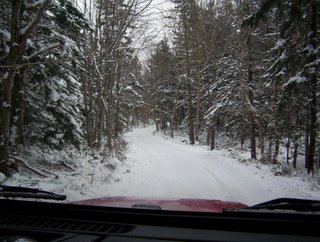Windshield view and old info

Before the storm started in earnest, yesterday morning Shel and I went for one of the short drives that we do on a regular basis. I'll put the whole ride together in pictures with a brief description later today. For now here is one picture that I took while on the old Crandall Lodge road in Argyle Head. As the lodge is now under new ownership I can't be sure if this road will still be known by this name, though to us it's how we'll remember it. The storm had petered out by the time it reached us here, after having left most of its snow along the eastern seaboard of the US. DD had received an email from a friend in Portland, ME during the early evening saying that they had only received about 4 inches there. Turned out to be just an ordinary winter storm for us for the most part.
Back home I spent some time with my nose in The Chestnut Pipe and came across some tidbits on subjects of interest to handcraft folks . . . .
Ink and Homemade Dyes
Good black ink was brewed from inkberry, Ilex glabra, and from maple bark. The same berries were used to make black dye, as was alder bark. Seaweed was gathered for a brown dye, and for yellow, onion skins were boiled. Lichens gave various dyes: "cockles" from maple trees provided a rich brown colur; old man's whiskers, a light sand or beige; rock cockles, light brown; and the stiff, shell-like rock lichen, a deep rose. Navy-blue dye was boiled from logwood brought from the West Indies in homeward bound vessels. To set the colours of homemade dyes, either a small lump of rock alum, salt and vinegar, or urine was added to the dye pot.
The natural colour of yarn spun from the wool of brown sheep was known as "heather" or "burnt"; "clouded" yarn was strands of yard dyed different colours.
Spinning and Weaving
In some homes there were looms, spinning wheels and "winding blades," to wind yarn into skeins. Cloth was woven for clothing and blankets, and for rugs to cover the bare floors. A single strand of yarn as it came from the spinning wheel was known as "open-banded"; for two-ply yarn, it was "double-and-twist"; for three-ply, "treble-the-three." Yarn spun from wool sheared from sheep that roamed their home pastures was known as "homeste'd"; clothing made from the yarn was known as homeste'd clothing. Those who remembered their grandmothers weaving yards of heavy cloth for pants and coats, remembered "plain weaving" had two threads; "swansdown" had four threads. Women went from house to house spinning for two cents a skein and weaving blanket cloth for seven cents a yard. One young widow, in Brass Hill, "buckled to" and made a living for her children weaving rag rugs. They were laid on the floor of the front room over a layer of oat straw. "Ingrain" carpets were woven in a pattern "one colour on top; another beneath," red above, gold beneath.
Mats
Mats were hooked of wool or of rags. Heavy rag mats were hooked on crocus bagging, the coarse burlap of oat or middling bags. A sturdy scatter mat for kitchen floors was a "sheeny mat," a "hit-and-miss," hooked of bright coloured rags, each row a different colour. A favourite design traced on burlap to be hooked in wool or finely cut rags, was of roses, thistles, and shamrocks within a border of scrolls, and against a "main" or background of grey, sand, or brown.
A coin mat was made with circles of flannel traced around coins that were feather-stitched in various designs onto squares of woolen cloth. The squares, feather-stitched together with a backing of blanket cloth, made an attractive bedroom mat.
Painted canvas mats were made for back entries and sinkrooms. Flour and cold water were mixed and boiled to a smooth paste that was brushed over the canvas. When dry, it was painted with odds and ends of house paint, with brightly coloured designs, bursting red roses, scrolls and geometric patterns, or a ship in full sail. Sometimes, yellow or red ochre paint was painted on the canvas as a background for the design.

3 Comments:
What often astonishes me is the beauty these busy people incorporated in their handmade items. Seems that it would have taken so much extra energy to make something useful that was also beautiful. Love reading about the names for things; thanks for sharing!
I know life was so often incredibly hard for these people, but how much satisfaction did they receive from creating all they needed themselves. Is that what we are missing in this commecialised world we live in?? Is that why so many of us are heading back to the basic ways of acheiving things?? Food for thought I gues.
Glad you enjoyed these postings Leslie. I'll try to share more shortly.
Yes Catherine, I think maybe the need to create something with our own hands is one reason. Also, I think many of us are just plain getting tired of the 'ratrace rush to nowhere.' As Alabama says in their song . . . . 'I'm in a hurry to get things done, Oh, I rush and rush until life's no fun. All I really got to do is live and die, And I'm in a hurry and I don't know why.' The peace and stillness surrounding you as you create . . . . whether it be handwork, baking, gardening, whatever . . . . is something your soul longs for.
Post a Comment
<< Home